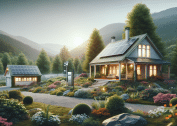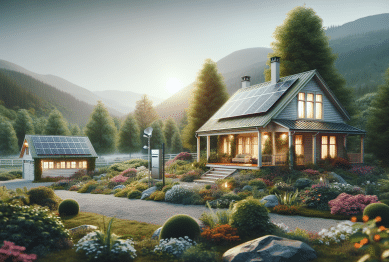Curious how native plants can create a beautiful, easy-care backyard oasis? Explore how sustainable landscaping with region-appropriate plants enriches biodiversity, saves water, and delivers a thriving, personal retreat — whether your space is cozy or expansive.
Why Native Plants Matter For Your Backyard
Native plants are adapted to the climate and soil conditions of their region, naturally thriving with minimal intervention. This makes them essential for homeowners seeking a low-maintenance, water-wise garden design. Incorporating native species helps preserve local wildlife, including birds, pollinators, and beneficial insects, fostering a dynamic ecosystem in your own backyard. Their deep roots increase soil stability and reduce erosion, further supporting the health of your outdoor space. Many garden enthusiasts discover native plants’ natural resilience, as these species rarely require fertilizers or pesticides, reducing the household’s environmental impact.
Switching to native landscaping often results in less yard work and more vibrant seasonal beauty. Unlike exotic ornamentals, native perennials, shrubs, and groundcovers typically demand fewer resources. They’re adapted to local rainfall patterns — a bonus for sustainable gardening. Colors change with the seasons, attracting butterflies and native bees year-round. Homeowners new to sustainable practices are frequently surprised by how quickly their outdoor areas rebound when switching to native plantings. These landscapes offer enduring beauty and ecological value, connecting the property to the larger environment.
Another key advantage is support for native fauna. Birds, like chickadees and warblers, depend on native seeds and insects for food. By planting milkweed or goldenrod, gardeners provide vital sustenance for monarch butterflies and helpful pollinators. This partnership between plant and animal life is a cornerstone of biodiversity. Ultimately, prioritizing native plants leads to healthier yards and neighborhoods, inspiring others to follow suit and foster a renewed sense of place in suburban, urban, and rural settings alike.
Planning Your Native Plant Landscape Design
Planning your backyard transformation starts with research. Identifying which species are native to your exact area is important for success. Many local extension services and botanical gardens publish lists of recommended plants for different climates and soil types, allowing homeowners to make informed choices. Sketching out sun and shade areas helps determine which native wildflowers, shrubs, or trees will flourish. A layered planting strategy — combining tall and short plants — boosts habitat diversity and enhances visual appeal.
Gardeners often create microhabitats to mimic nature. For example, a mix of ground covers, grasses, and flowering perennials can cover bare soil and attract beneficial organisms. These plantings help suppress weeds naturally and conserve moisture. Paths, rocks, and mulch define outdoor rooms and support native plantings by retaining soil moisture and reducing runoff. Consulting local resources — from master gardener programs to conservation groups — can yield advice, plans, and even native plant sales that make the initial setup easier and more affordable.
When mapping out garden beds, consider the long-term growth of each selected plant. Many natives spread over time, so giving them proper space is key. Selecting a variety of textures and bloom times ensures visual interest throughout the year and lengthens food availability for wildlife. Some homeowners start with a smaller pilot plot and expand as plants mature, adapting their gardening style as they observe what thrives in their unique backyard environment. Patience pays off with robust, established plant communities that require little supplemental water or care.
Water Conservation and Irrigation Tips
One of the hallmark benefits of native plant gardening is reduced water use. Because natives are naturally suited to local rainfall patterns, they generally need less irrigation once established. In regions with prolonged drought, selecting drought-tolerant natives can make water-wise landscaping possible. Drip irrigation systems or soaker hoses provide moisture directly to the roots while minimizing evaporation. Mulching beds with natural materials — like shredded leaves or bark — further conserves soil moisture and reduces the need for frequent watering.
For homeowners looking to maximize water savings, rain gardens offer a practical solution. Planted in low spots, these gardens slow and absorb runoff from impervious surfaces such as roofs and driveways. Selecting water-loving native plants for these areas prevents pooling and erosion. Beyond rain gardens, using rain barrels to collect rooftop water diverts precious resources for deep-root watering during dry spells. Grouping plants with similar water needs in zones makes it easier to irrigate efficiently, giving high-need areas priority during periods of drought.
It’s not just about saving money — water efficiency benefits local watersheds by reducing stormwater runoff and pollution. Over time, native landscapes can survive solely on rainfall, eliminating dependency on supplemental irrigation. Homeowners often observe that, even during dry stretches, well-chosen native species bounce back quickly after a soaking rain. This resilience strengthens the overall health of the yard, establishing a truly sustainable outdoor living space that supports climate change adaptation at the household level.
Maintaining a Healthy Native Plant Garden
Maintaining a native garden is generally simpler than tending to traditional lawns and exotic beds. Routine care involves seasonal tasks like removing invasive weeds, refreshing mulch, and dividing mature plants. Native grasses and wildflowers rarely require fertilizers, as they have adapted to local soils. Occasional pruning may be needed to shape shrubs or control enthusiastic growers, but most plants will naturally fill their allotted space. This low-impact approach frees up time for other outdoor activities or simply enjoying your yard’s natural beauty.
Integrated pest management is a core principle in native gardening. Because native plant communities support a diverse food web, natural predators help keep pests in check. Encouraging beneficial insects and birds reduces the need for chemical control methods. In the event of an outbreak, manual removal or spot treatments with eco-friendly products can resolve issues while safeguarding pollinator populations. Most diseases common in ornamentals are rare in native species, thanks to their natural defenses.
Seasonal adjustment is important, too. In autumn, many gardeners let seed heads and stems remain standing to provide food and shelter for wildlife during the winter months. Leaf litter serves as protective mulch and habitat for overwintering insects. As spring arrives, gently clearing debris and thinning aggressive growers maintains balance. Homeowners often report a sense of accomplishment as their native plant landscapes mature, becoming more self-sustaining and visually striking each year with minimal intervention.
Attracting Wildlife and Enhancing Biodiversity
Native gardens act as critical habitats for a dazzling array of wildlife. By planting a mix of flowering natives, homeowners attract pollinators like bees, butterflies, and hummingbirds. Berry-producing shrubs support songbirds, while grasses and sedges provide shelter for ground-dwelling creatures. Even small water sources — birdbaths or shallow ponds — can welcome amphibians and insects. Observing these visitors brings daily delight and ties the home landscape to broader conservation efforts in the region.
Enhancing biodiversity starts with variety. Different heights, textures, and bloom periods cater to many types of animals, ensuring food and shelter are available across the seasons. Letting a portion of your backyard remain undisturbed — a brush pile or dense thicket — offers refuge for shy species. Incorporating features like log piles and native wildflower meadows gives wildlife more opportunities to thrive. Resources such as local conservation organizations or university extension offices offer guidelines for creating wildlife-friendly landscapes tailored to each area.
These intentional gardening choices go beyond aesthetics. Nurturing pollinators and birds helps sustain regional agriculture and supports threatened species, many of which have lost habitat to development. Many gardeners find their sense of stewardship deepening as they witness the ripple effects of their efforts — from the return of rare butterflies to a chorus of nesting wrens. This deep relationship with nature enriches the sense of home and inspires ongoing curiosity about ecology, restoration, and local species’ lifecycles.
Overcoming Common Challenges in Native Landscaping
While the transition to native plants brings rich rewards, gardeners may face initial hurdles. New beds can look sparse in the first season, as native plants devote energy to root growth instead of top growth. Patience is crucial. Regular monitoring for invasive weeds and learning to distinguish seedlings from volunteers ensures that the original planting plan stays on track. Soil preparation, especially if compacted or nutrient-poor, sometimes requires added organic matter before planting. These early steps build the foundation for a vibrant, low-maintenance landscape.
Access to native plants has improved, but selection may still be limited in some nurseries. Homeowners benefit by seeking out specialized native plant sales, community swaps, or online resources run by conservation groups. Transplanting from wild areas is discouraged, as it can harm sensitive native populations; sourcing from reputable growers ensures ecological integrity. Education also plays a role, as some neighbors are unaccustomed to the wilder look of native gardens. Sharing knowledge about benefits and beauty can inspire others and help change local norms.
Occasional setbacks — like unseasonal weather, pest outbreaks, or plant failures — are to be expected. Flexibility and observation let gardeners adapt, gradually refining their yard with every season. Over time, the rewards multiply: lush growth, captivating wildlife, and a sustainable outdoor living space. Many homeowners discover newfound pride and satisfaction knowing their yard supports both personal wellbeing and broader ecological goals, offering opportunities to connect, learn, and share with neighbors and community groups.
References
1. U.S. Environmental Protection Agency. (n.d.). Green Landscaping: Greenacres. Retrieved from https://www.epa.gov/greenacres
2. National Wildlife Federation. (n.d.). Garden for Wildlife. Retrieved from https://www.nwf.org/Garden-for-Wildlife/About
3. Missouri Botanical Garden. (n.d.). Native Landscaping Manual. Retrieved from https://www.missouribotanicalgarden.org/gardens-gardening/gardening-in-st-louis/sustainable-living/native-landscaping.aspx
4. University of California Agriculture & Natural Resources. (n.d.). Sustainable Landscaping. Retrieved from https://ucanr.edu/sites/scmg/Sustainable_Gardening/Sustainable_Landscaping/Native_Plants/
5. Lady Bird Johnson Wildflower Center. (n.d.). Why Natives? Retrieved from https://www.wildflower.org/learn/why-natives
6. PennState Extension. (n.d.). Supporting Pollinators with Native Plants. Retrieved from https://extension.psu.edu/supporting-pollinators-with-native-plants









